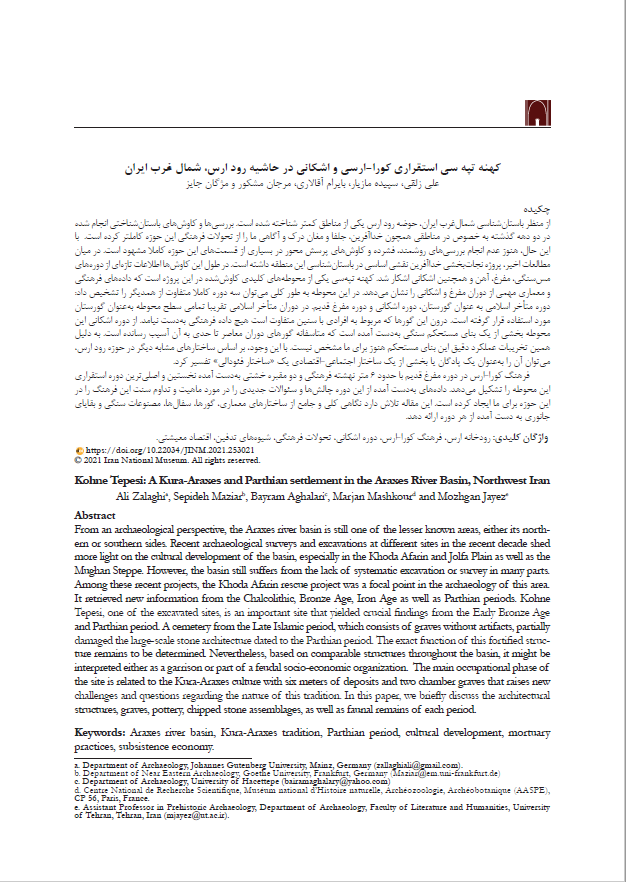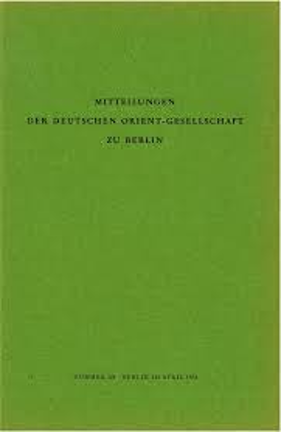Publications so far
0
| 1. |  | Zalaghi, Ali; Maziar, Sepideh; Aghalari, Bayram; Mashkour, Marjan; Jayez, Mozhgan: Kohne Tepesi: A Kura-Araxes and Parthian settlement in the Araxes River Basin, Northwest Iran. In: Journal of Iran National Museum, vol. 2, no. 1, 2021. (Type: Journal Article | Abstract | Links | BibTeX)@article{nokey,From an archaeological perspective, the Araxes river basin is still one of the lesser known areas, either its northern or southern sides. Recent archaeological surveys and excavations at different sites in the recent decade shed more light on the cultural development of the basin, especially in the Khoda Afarin and Jolfa Plain as well as the Mughan Steppe. However, the basin still suffers from the lack of systematic excavation or survey in many parts. Among these recent projects, the Khoda Afarin rescue project was a focal point in the archaeology of this area. It retrieved new information from the Chalcolithic, Bronze Age, Iron Age as well as Parthian periods. Kohne Tepesi, one of the excavated sites, is an important site that yielded crucial findings from the Early Bronze Age and Parthian period. A cemetery from the Late Islamic period, which consists of graves without artifacts, partially damaged the large-scale stone architecture dated to the Parthian period. The exact function of this fortified structure remains to be determined. Nevertheless, based on comparable structures throughout the basin, it might be interpreted either as a garrison or part of a feudal socioeconomic organization. The main occupational phase of the site is related to the Kura-Araxes culture with six meters of deposits and two chamber graves that raises new challenges and questions regarding the nature of this tradition. In this paper, we briefly discuss the architectural structures, graves, pottery, chipped stone assemblages, as well as faunal remains of each period. |
| 2. |  | Brown, Michael: The Mountain Fortresses of Rabana-Merquly in Iraqi-Kurdistan. In: BAF-Online: Proceedings of the Berner Altorientalisches Forum, vol. 4, no. 1, 2020. (Type: Journal Article | Abstract | Links | BibTeX)@article{nokey,The twin fortresses of Rabana-Merquly are situated on the western side of Mt. Piramagrun, one of the most prominent massifs in the Zagros Mountains. A defining feature of these adjoining settlements are their matching, approximately life-size rock-reliefs depicting a ruler in Parthian dress, which flank the entrance to both sites. Behind the perimeter walls several structures have been recorded including a citadel and a sanctuary complex. The combined intramural area is in excess of 40 hectares. Based on the style of relief sculptures, and the material culture of their associated intramural settlements, occupation is dated to the early first millennium A.D. Investigations at Rabana-Merquly are a collaboration between Heidelberg University and the Sulaymaniyah Directorate of Antiquities. This talk gives an overview of the main fieldwork results to date, emphasizing the relationship between the fortified settlements and the wider landscape of the central Zagros highlands. |
| 3. |  | Brown, Michael; Rasheed, Kamal; Dörr, Roxana; Heiler, Jan: Die Bergbefestigung von Rabana-Merquly in Irakisch-Kurdistan: Ein Vorbericht der Grabungskampagne 2019. In: Mitteilungen der Deutschen Orient-Gesellschaft, iss. 152, pp. 91-110, 2020. (Type: Journal Article | Abstract | Links | BibTeX)@article{nokey,On the slopes of Mt. Piramagrun in the Zagros Mountains of Iraqi Kurdistan lies the fortified site of Rabana-Merquly. Ruins spread across c. 100 ha represent a major occupation during the Parthian period. Matching rock-reliefs that depict an anonymous ruler flank the two main entrances to the settlements. Pronounced similarities in attire between these sculptures and the statue of a king of Adiabene found at Hatra suggest a possible identification for both the individual depicted in relief (Natounissar) and the ancient city (Natounia-on-the-Kapros). Fieldwork in 2019 continued our ongoing programme of survey and excavation, with more detailed investigation of the complex at the entrance to Rabana valley. |
| 4. | Herrmann, Georgina: Parthian and Sasanian Saddlery. New Light from the Roman West. In: de Meyer, L.; Haerinck, E. (Ed.): Archaeologia Iraníca et Orientalis. Miscellanea in Honorem Louis Vanden Berghe (1989)
, vol. 2, pp. 757-809, Peeters, 1989. (Type: Book Chapter | BibTeX)@inbook{nokey, | |
| 5. | Hallier, Ulrich W.: Neh – eine parthische Stadt in Ostpersien. In: Archäologische Mitteilungen aus Iran, Neue Folge, vol. 7, pp. 173–190, 1974. (Type: Journal Article | BibTeX)@article{nokey, |
2021 |
|
 | Zalaghi, Ali; Maziar, Sepideh; Aghalari, Bayram; Mashkour, Marjan; Jayez, Mozhgan: Kohne Tepesi: A Kura-Araxes and Parthian settlement in the Araxes River Basin, Northwest Iran. In: Journal of Iran National Museum, vol. 2, no. 1, 2021. (Type: Journal Article | Abstract | Links | BibTeX | Tags: Kura-Araxes, Parthian, Settlement structure)@article{nokey,From an archaeological perspective, the Araxes river basin is still one of the lesser known areas, either its northern or southern sides. Recent archaeological surveys and excavations at different sites in the recent decade shed more light on the cultural development of the basin, especially in the Khoda Afarin and Jolfa Plain as well as the Mughan Steppe. However, the basin still suffers from the lack of systematic excavation or survey in many parts. Among these recent projects, the Khoda Afarin rescue project was a focal point in the archaeology of this area. It retrieved new information from the Chalcolithic, Bronze Age, Iron Age as well as Parthian periods. Kohne Tepesi, one of the excavated sites, is an important site that yielded crucial findings from the Early Bronze Age and Parthian period. A cemetery from the Late Islamic period, which consists of graves without artifacts, partially damaged the large-scale stone architecture dated to the Parthian period. The exact function of this fortified structure remains to be determined. Nevertheless, based on comparable structures throughout the basin, it might be interpreted either as a garrison or part of a feudal socioeconomic organization. The main occupational phase of the site is related to the Kura-Araxes culture with six meters of deposits and two chamber graves that raises new challenges and questions regarding the nature of this tradition. In this paper, we briefly discuss the architectural structures, graves, pottery, chipped stone assemblages, as well as faunal remains of each period. |
2020 |
|
 | Brown, Michael: The Mountain Fortresses of Rabana-Merquly in Iraqi-Kurdistan. In: BAF-Online: Proceedings of the Berner Altorientalisches Forum, vol. 4, no. 1, 2020. (Type: Journal Article | Abstract | Links | BibTeX | Tags: Fortification, Kurdistan, Landscape, Parthian, Persian empire, Resilience)@article{nokey,The twin fortresses of Rabana-Merquly are situated on the western side of Mt. Piramagrun, one of the most prominent massifs in the Zagros Mountains. A defining feature of these adjoining settlements are their matching, approximately life-size rock-reliefs depicting a ruler in Parthian dress, which flank the entrance to both sites. Behind the perimeter walls several structures have been recorded including a citadel and a sanctuary complex. The combined intramural area is in excess of 40 hectares. Based on the style of relief sculptures, and the material culture of their associated intramural settlements, occupation is dated to the early first millennium A.D. Investigations at Rabana-Merquly are a collaboration between Heidelberg University and the Sulaymaniyah Directorate of Antiquities. This talk gives an overview of the main fieldwork results to date, emphasizing the relationship between the fortified settlements and the wider landscape of the central Zagros highlands. |
 | Brown, Michael; Rasheed, Kamal; Dörr, Roxana; Heiler, Jan: Die Bergbefestigung von Rabana-Merquly in Irakisch-Kurdistan: Ein Vorbericht der Grabungskampagne 2019. In: Mitteilungen der Deutschen Orient-Gesellschaft, iss. 152, pp. 91-110, 2020. (Type: Journal Article | Abstract | Links | BibTeX | Tags: Fortification, Kurdistan, Landscape, Parthian, Resilience)@article{nokey,On the slopes of Mt. Piramagrun in the Zagros Mountains of Iraqi Kurdistan lies the fortified site of Rabana-Merquly. Ruins spread across c. 100 ha represent a major occupation during the Parthian period. Matching rock-reliefs that depict an anonymous ruler flank the two main entrances to the settlements. Pronounced similarities in attire between these sculptures and the statue of a king of Adiabene found at Hatra suggest a possible identification for both the individual depicted in relief (Natounissar) and the ancient city (Natounia-on-the-Kapros). Fieldwork in 2019 continued our ongoing programme of survey and excavation, with more detailed investigation of the complex at the entrance to Rabana valley. |
1989 |
|
Herrmann, Georgina: Parthian and Sasanian Saddlery. New Light from the Roman West. In: de Meyer, L.; Haerinck, E. (Ed.): Archaeologia Iraníca et Orientalis. Miscellanea in Honorem Louis Vanden Berghe (1989)
, vol. 2, pp. 757-809, Peeters, 1989. (Type: Book Chapter | BibTeX | Tags: Parthian, Sasanian)@inbook{nokey, | |
1974 |
|
Hallier, Ulrich W.: Neh – eine parthische Stadt in Ostpersien. In: Archäologische Mitteilungen aus Iran, Neue Folge, vol. 7, pp. 173–190, 1974. (Type: Journal Article | BibTeX | Tags: Parthian)@article{nokey, | |
